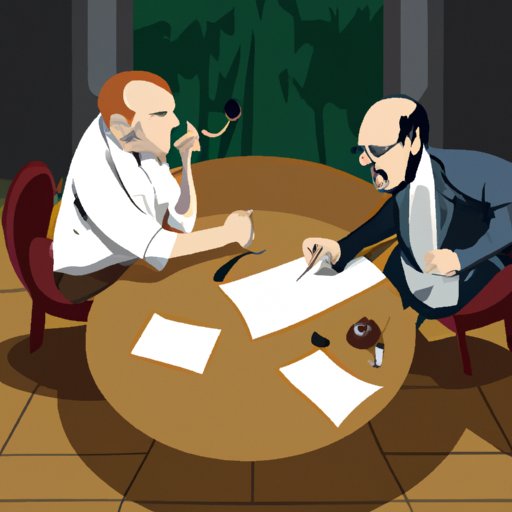Introduction
Creating an effective and captivating short story can be a daunting task. To craft a successful story, you must have a clear understanding of the characters, setting, plot, and resolution. It’s also important to come up with an interesting opening sentence that will draw in your readers. In this article, we’ll explore the best strategies for starting to write a short story.
Start with a strong opening sentence
The first sentence of your story is critical. It should be intriguing and provoke curiosity in the reader. You want to create an opening line that will immediately grab the reader’s attention. Here are some examples of strong opening sentences:
- “It was a dark and stormy night.” – Edward Bulwer-Lytton
- “The sun shone, having no alternative, on the nothing new.” – Samuel Beckett
- “It was the best of times, it was the worst of times.” – Charles Dickens
When crafting your opening sentence, make sure it sets the tone for the rest of the story and introduces the main theme. It should also provide a hint of what the story is about without giving away too much. Here are some tips for creating an effective opening sentence:
- Start with something unexpected or shocking.
- Introduce a problem or mystery.
- Use sensory details to create a vivid image.
- Set the scene with a description of the setting.
Create interesting characters
Your characters should be dynamic and engaging. They should have distinct personalities, strengths, and weaknesses. Think about who your protagonist is and what their motivations are. What kind of obstacles will they face? What makes them unique? Here are some ways to make your characters unique and memorable:
- Give them unique physical characteristics.
- Develop their backstory and history.
- Make them relatable and likable.
- Give them interesting quirks or mannerisms.
In addition to creating unique characters, you should also give them depth and complexity. This means making them multi-faceted and giving them conflicting desires and motivations. Think about how your characters will grow and change throughout the story. How will they respond to different situations? How will they interact with other characters?
Establish the setting
The setting of your story is just as important as the characters. It should be vivid and believable. Start by describing the physical environment. Where does the story take place? What does it look like? What kind of climate does it have? Once you’ve established the physical environment, think about how it affects the characters and the plot.
Here are some tips for developing a sense of atmosphere:
- Use sensory details to evoke emotion in the reader.
- Include details about the culture and customs of the area.
- Describe the people and their relationships.
- Think about how the environment affects the characters.
Develop a plot
Once you have your characters and setting in place, it’s time to develop a plot. The plot should be compelling and interesting. Think about the main conflict and how it will be resolved. What will the protagonist have to overcome? What challenges will they face? Here are some strategies for coming up with a compelling story:
- Start with a hook that draws in the reader.
- Introduce a problem or challenge for the protagonist to solve.
- Create suspense by gradually revealing information.
- Establish a clear goal for the protagonist.
- Include twists and turns to keep the reader guessing.
You should also think about pacing. You don’t want your story to move too quickly or too slowly. Keep the reader engaged by introducing new elements at regular intervals. Use dialogue and action to move the story forward and create tension.
Introduce conflict and tension
Conflict and tension are essential elements of any good story. Think about how you can introduce tension into your story. You should also consider how the protagonist will react to the conflict. Here are some examples of how to introduce tension into a story:
- Create a ticking clock by setting a deadline.
- Introduce an antagonist who presents a challenge to the protagonist.
- Raise the stakes with higher consequences.
- Have the protagonist face moral dilemmas.
- Include unexpected twists and reversals.
To create a sense of suspense, you should also focus on the emotions of the characters. Describe how they feel in each moment and how those feelings affect their decisions. Make sure the tension builds throughout the story until the climax.

End with a satisfying resolution
A satisfying resolution is essential for a successful short story. The ending should provide closure and leave the reader feeling fulfilled. Here are some ideas for creating satisfying endings:
- Provide a resolution to the main conflict.
- Tie up any loose ends.
- Leave the reader with a sense of hope.
- Show how the characters have grown and changed.
- Reveal how the protagonist has achieved their goals.
When crafting your ending, make sure to avoid clichés and predictability. You want to surprise the reader and leave them with something to think about. Here are some tips for tying up loose ends:
- Resolve any subplots.
- Explain any unanswered questions.
- Show how the characters have grown.
- Provide closure for any unresolved issues.
Conclusion
Writing a successful short story requires careful planning. To start writing a short story, you must create interesting characters, establish a vivid setting, develop a compelling plot, introduce conflict and tension, and end with a satisfying resolution. By following these steps, you can craft an effective and captivating short story.
(Note: Is this article not meeting your expectations? Do you have knowledge or insights to share? Unlock new opportunities and expand your reach by joining our authors team. Click Registration to join us and share your expertise with our readers.)
